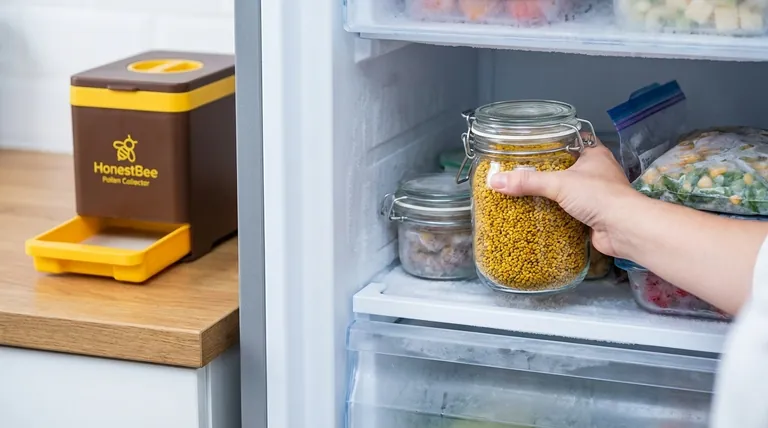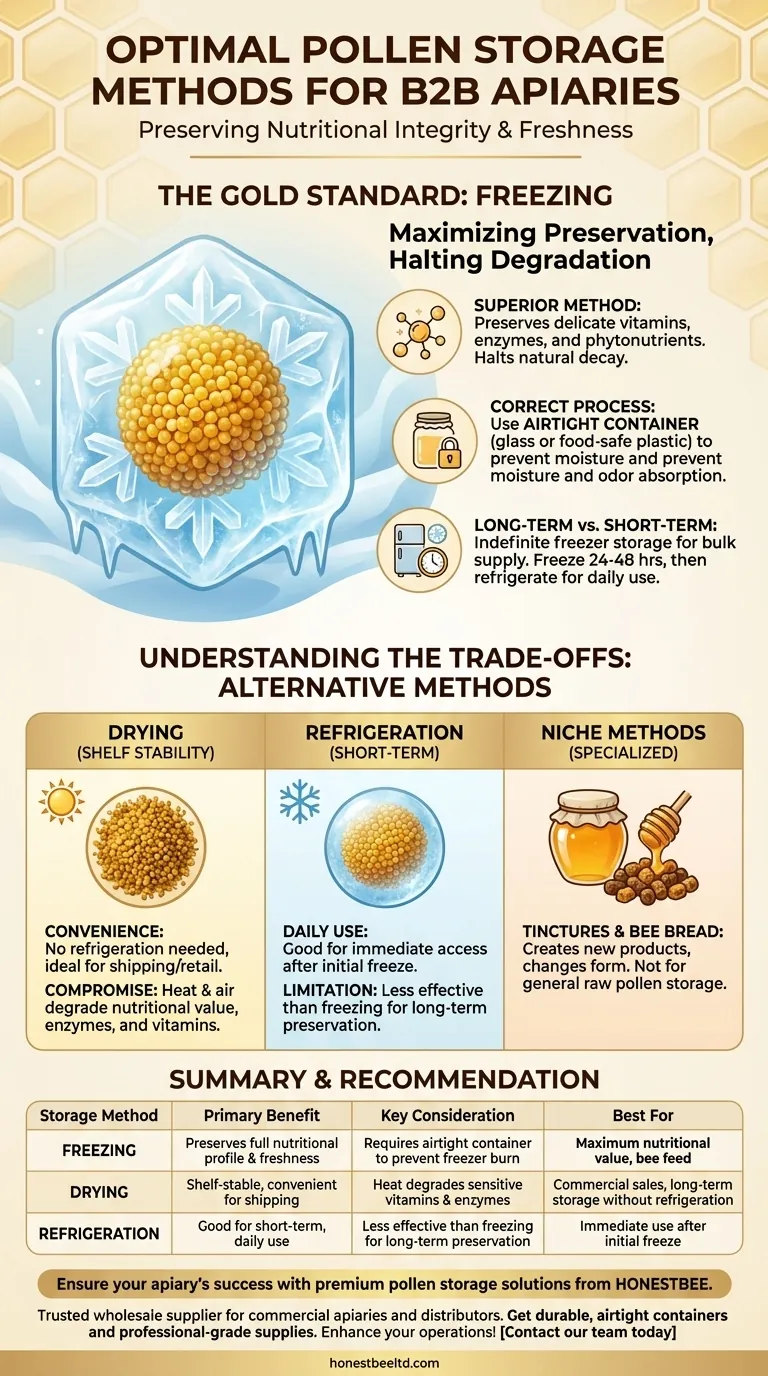Ultimately, the best way to store pollen is to freeze it. This method is overwhelmingly preferred because it does the best job of preserving the pollen's full nutritional profile, freshness, and sensitive compounds. While other methods exist, they involve significant trade-offs in quality.
The core principle of pollen storage is a race against degradation. Freezing is the most effective method because it halts the natural decay of sensitive vitamins and enzymes, preserving the pollen in a state as close to fresh as possible.

The Gold Standard: Freezing for Maximum Preservation
Freezing is the superior method because it maintains the pollen's nutritional integrity. Fresh pollen is a biologically active substance, and freezing effectively pauses this activity without destroying its beneficial components.
Why Freezing Is Superior
Freezing safeguards the delicate vitamins, enzymes, and other phytonutrients that make pollen so valuable. Methods like drying, which use heat, can degrade or destroy these heat-sensitive compounds, diminishing the pollen's overall quality.
For uses like bee feed, freezing raw, undried pollen is critical for preserving its maximum nutritional content, ensuring the colony receives the full benefit.
How to Freeze Pollen Correctly
The process is straightforward. Place the fresh pollen in a clean, airtight container before putting it in the freezer. Glass or food-safe plastic containers work well.
The airtight seal is non-negotiable. It prevents moisture from causing freezer burn and protects the pollen from absorbing odors from other foods.
Long-Term vs. Short-Term Storage
For long-term storage, pollen can be kept in the freezer indefinitely. It remains a practical and efficient way to keep a large supply.
For more immediate or daily use, a common technique is to freeze the pollen for 24-48 hours first, then transfer it to the refrigerator. This provides a ready-to-use supply while still offering better preservation than simply refrigerating from the start.
Understanding the Trade-offs
While freezing is best for quality, other methods exist for different needs, primarily shelf stability. It's crucial to understand what you gain and what you lose with each approach.
The Compromise of Drying
Drying pollen makes it shelf-stable, removing the need for refrigeration or freezing. This adds convenience, especially for commercial shipping or retail.
However, this convenience comes at a cost. The heat and air exposure involved in drying inevitably degrade the pollen's nutritional value, particularly its fragile enzymes and vitamins.
Other Niche Methods
Some sources mention creating tinctures or mixing pollen with honey to create a "bee bread" style product. These are specialized preservation techniques for specific applications, not general-purpose storage.
These methods fundamentally change the pollen's form and are more about creating a new product than preserving the raw pollen itself.
Making the Right Choice for Your Goal
Your storage method should align directly with your primary objective.
- If your primary focus is maximum nutritional value: Freeze your pollen in an airtight container for both short-term and long-term storage.
- If your primary focus is convenience and shelf stability: Drying is an option, but you must accept the significant reduction in nutritional quality.
- If you are feeding bees: Always choose freezing for undried pollen to provide them with the highest quality food source.
Ultimately, proper storage is about locking in the unique benefits of the pollen at its peak freshness.
Summary Table:
| Storage Method | Primary Benefit | Key Consideration | Best For |
|---|---|---|---|
| Freezing | Preserves full nutritional profile & freshness | Requires airtight container to prevent freezer burn | Maximum nutritional value, bee feed |
| Drying | Shelf-stable, convenient for shipping | Heat degrades sensitive vitamins & enzymes | Commercial sales, long-term storage without refrigeration |
| Refrigeration | Good for short-term, daily use | Less effective than freezing for long-term preservation | Immediate use after initial freeze |
Ensure your apiary's success with premium pollen storage solutions from HONESTBEE. As a trusted wholesale supplier to commercial apiaries and beekeeping equipment distributors, we provide the durable, airtight containers and equipment needed to properly freeze and preserve pollen, safeguarding its nutritional integrity for your colonies. Enhance your beekeeping operations with our professional-grade supplies—contact our team today to discuss your wholesale needs!
Visual Guide

Related Products
- Removable Plastic Pollen Trap With Ventilated Tray for Bees Pollen Collector
- Wooden Bee Brush with Triple Row Artificial Fiber for Beekeeping
- Classic Wooden Bee Brush with Double-Row Boar Bristles
- Yellow Plastic Bucket Pail Perch for Beekeeping
- Extra Wide Stainless Steel Honey Uncapping Fork with Scraper Beekeeping Tool
People Also Ask
- What are the key features of an effective pollen trap? Maximize Harvests & Protect Hive Health
- What are the different types of pollen traps available? A Guide to Front-Porch & Bottom-Mounted Designs
- How do bees adjust to a new pollen trap entrance? Ensure a Smooth Transition for Your Hive
- What are the primary reasons beekeepers collect bee pollen? Boost Hive Health and Generate Income
- What are the main uses of bee-collected pollen? A Guide for Apiary Management and Product Sales



















